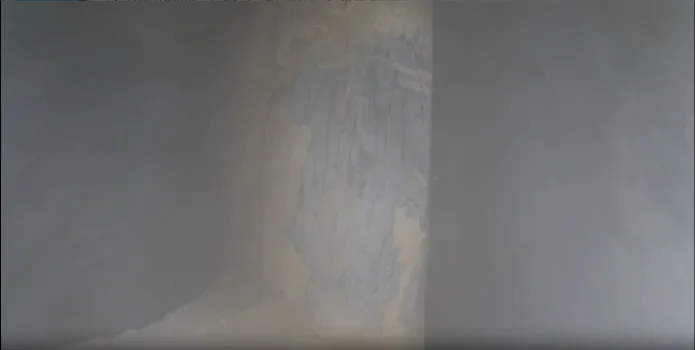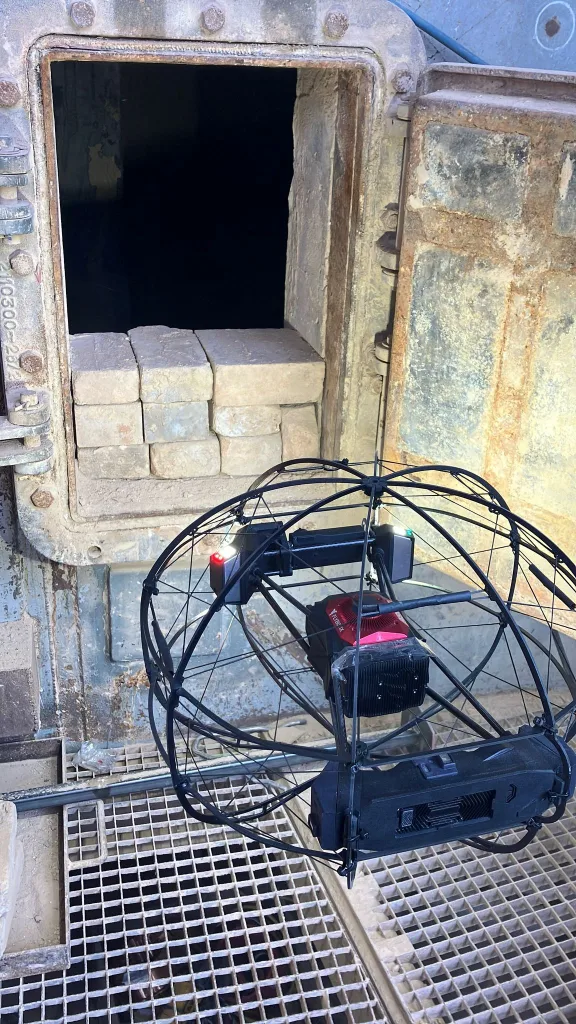PROOF OF CONCEPT
Drone inspection of cement asset: Cement Cyclone Safety using ASIO X
Discover how drone-based inspections are transforming cement plant maintenance
Flight time
20 minutes
ASIO X
Drone
Proof of
Concept
Industry
Cement
Introduction
In the demanding world of the cement industry, maintaining the health of critical infrastructure is essential. Yet, traditional inspection methods in cement plants — from climbing towering chimneys to setting up expensive scaffolding inside massive silos and cyclones — present significant challenges. Additionally, these methods often expose workers to hazardous environments, cause extended downtime, and increase costs without ensuring complete coverage or deep insights.
As cement production ramps up globally, the need for faster, safer, and more reliable inspections is more urgent than ever. Improving the efficiency and reliability of inspections in the cement industry isn’t just about cost savings — it’s about ensuring plant longevity, protecting workers, and maintaining the high operational standards expected of today’s global cement leaders.
Holcim, a global leader in building materials manufacturing, understands this better than most. The company integrated drones into its asset inspection strategy for years, leveraging the technology to enhance safety, reliability, and efficiency across its operations.
To explore potential improvements, the company set out to compare Flybotix’s ASIO solution with its existing inspection systems and determine whether it could enhance or complement their current methods.
Mission's Objectives:
- Check if the drone can fly for 20 minutes in heavy dust conditions.
- Inspect cyclone walls inside a cement pre-heater tower.
We will present the mission results, the specific challenges of inspecting cement cyclones, and how ASIO X is setting new standards for safety, accuracy, and efficiency.
Why Traditional Inspection Methods in Cement Plants Fall Short
Maintaining the structural integrity of cement plant assets is essential for safe and efficient cement production. However, traditional inspection methods — involving scaffolding, rope access, and manual confined space entry —lead to risks, delays, and high costs.
Key Safety risks

Work at
Height
Risk of falling from significant heights

Confined Space
Entry
Tight, poorly ventilated areas with limited escape routes

Hazardous Environments
Risk of burns, respiratory issues, and accidents

Scaffolding Challenges
Risks of falls, structural failure, falling objects, and dust exposure

Rope Access
Risks
Risk of slips, falls, and entanglement with internal obstacles
Specific to cyclones, the risks are even greater. According to an article published by ZKG Cement Lime Gypsum, “the work required for the elimination of cyclone blockages is among the most dangerous in the process of cement production.”
In fact, over time, material can accumulate along the walls of the cyclones, creating thick deposits that obstruct the flow of hot gases and raw materials. If these blockages are not addressed, they can lead to unplanned shutdowns, production delays, and potential safety hazards, resulting in significant costs.
Manually removing the blockages poses significant dangers, as workers must operate in confined, high-temperature environments filled with dust and unstable debris. This exposes them to various risks, including burns, respiratory issues, and accidents caused by sudden collapses of hardened material.
Therefore, drones represent an ideal solution for inspecting the interiors of cyclones. They evaluate the extent of material buildup before it causes a blockage. By identifying problem areas early, drones help prevent disruptions and reduce the need for hazardous manual intervention.




Internal view of the cement cyclone captured by the ASIO X drone during the mission.
The Role of Drone Technology in Modern Cement Plant Inspection
As the demands for safety, efficiency, and precision grow in the cement industry, drone technology is becoming a critical tool for plant inspection. These compact, powerful systems provide a smarter way to monitor and maintain complex assets while significantly enhancing inspection efficiency.
Advantages of Drone Inspection Over Traditional Methods
As the demands for safety, efficiency, and precision grow in the cement industry, drone technology is becoming a critical tool for plant inspection. These compact, powerful systems provide a smarter way to monitor and maintain complex assets while significantly enhancing inspection efficiency.
1. Improved Overall Safety of the Inspection
One of the most significant benefits of using drones for cement inspections is how they transform safety standards. Traditionally, human inspectors are required to physically enter confined spaces, often using scaffolding or rope access in hazardous environments. This exposes workers at risks such as extreme heat, unstable materials, and limited visibility.
Indoor drones can perform these inspections remotely, eliminating the need for human entry and, therefore, enhancing the overall safety of the inspection process.
2. Real-Time Data and Visual Insights
ASIO X, equipped with 4K cameras and 40,000-lumen lighting systems, can capture real-time visual data even in highly dusty environments.
This means teams no longer rely solely on manual documentation or memory-based assessments. Instead, visual data is recorded, analysed, and archived, providing asset managers and maintenance engineers with a clear, objective view of a structure’s condition with higher precision when needed.
3. Reducing the Need for Human Entry
Large cement production assets are notoriously difficult and dangerous to inspect. They are physically hard to access and filled with dust, heat, and potential falling debris.
With drone inspection, these areas can be thoroughly examined without requiring personnel to enter them. As demonstrated in Holcim’s mission, drones can safely fly inside cyclones under heavy dust conditions, assess structural integrity, and capture key imagery that helps prevent costly issues like blockages or erosion—without shutting down the plant or putting inspectors at risk
Increasing the Frequency of Inspections with Drones for Cement Cyclone Assets
In cement production, regular inspection of critical assets is crucial for preventing failures, minimising unplanned downtime, and prolonging equipment life. However, traditional inspection methods—often requiring shutdowns, scaffolding, or confined space entry—make it costly and time-consuming to inspect as frequently as needed.
Drone technology empowers cement plants to increase their inspection frequency significantly without driving up operational costs by enabling quicker, safer, and less disruptive inspections.
Why Increased Frequency of Inspections Matters
Routine inspections have always been essential in the cement industry; however, traditional constraints often result in lengthy intervals between them. Unfortunately, this gap increases the chance to miss early damage, or material buildup, particularly in high-risk areas.
By enabling more frequent inspections, visual inspection drones make it easier to detect issues before they escalate. For instance, cracks in cyclone walls, refractory lining degradation inside kilns, or early buildup in silos can all be caught earlier, allowing for more proactive maintenance planning.
This enhances safety, protects uptime, limits emergency shutdowns, and ultimately reduces maintenance costs.
How ASIO X Makes Frequent Inspections Feasible
ASIO X quickly inspect critical assets, even in harsh, dusty environments. It can navigate confined spaces in minutes, capture visual data, and return with actionable insights.
What’s more, it allows inspectors to reach previously inaccessible zones, such as deep inside a cyclone or along a tall silo wall, where work-at-height risks or physical obstacles are used to limit coverage.
Thanks to extended flight times and stable navigation, a single inspection flight can target multiple internal structures, further streamlining the process.
This makes frequent inspections possible and practical and opens a new era of preventive maintenance in the cement industry.
Choosing the Right Drone for Your Cement Plant
Selecting the right drone is crucial for cement companies that operate in highly challenging environments. As seen during Holcim’s mission, most drone can’t perform under the extreme conditions found in the cement industry.
The mission highlighted what it truly takes for a drone to succeed in critical assets.
Key Technical Challenges for Cement Plant Drones
Operating inside a cement cyclone presents at least three significant challenges for traditional drones:
- Stability Issues: In GPS-denied environments, drones mostly rely on optical sensors for balance. Yet, these sensors can fail in heavy dust.
- Environmental Hazards: Dust infiltration can damage drone components, and obstacles such as falling debris, thermometer probes, and hanging objects increase the risks when visibility is poor.
- Battery Limitations: Short flight times mean pilots have limited windows to conduct thorough inspections, which increases stress and reduces efficiency.
How ASIO X Overcame These Challenges
ASIO X was designed to perform well in environments with heavy dust. During this mission, it demonstrated four key advantages that set it apart:
1️ - Stability in Dust-Filled Environments
ASIO X features a cutting-edge RADAR system that is unaffected by visual obstructions. It delivers stable and precise navigation even in the most challenging conditions when combined with Flybotix’s advanced stabilisation algorithms.
2 - Lower Maintenance and Longer Lifespan
One of the biggest challenges in cement inspections is drone durability. ASIO X’s design minimises dust exposure to critical components, meaning:
- ASIO's Swiss-made motors are designed to last even in the most challenging conditions
- Bigger, slower-spinning propellers reduce wear and power, extending lifespan
3 - Extended Flight Time for More Efficient Inspections
A key success factor in the Holcim inspection was ASIO X’s extended flight time (up to 20 minutes), up to 2.5 times longer than other drones in this market. This gave the pilot:
- More time to assess the asset's condition
- Reduced pilot stress, especially in low-visibility environments
4 - High-Quality Imaging for Precise Analysis
The drone’s 4K camera and market-leading, powerful 40,000-lumen lighting system delivered crystal-clear visuals, even in the cyclone’s very dusty interior. This ensured that every structural detail was captured for analysis, leading to more accurate maintenance decisions.

ASIO X entering the confined space of the cement cyclone
Conclusion
In conclusion, regular inspection of cement assets is crucial for preventing failures, minimising unplanned downtime, and prolonging equipment life.
However, traditional inspection methods—often requiring shutdowns, scaffolding, or confined space entry—make it costly and time-consuming to inspect as frequently as needed.
Drone technology empowers cement plants to increase their inspection frequency significantly without driving up operational costs by enabling quicker, safer, and less disruptive inspections.
ELEVATE YOUR INSPECTION PROCESS
Talk to Our Team
Connect with our team for a firsthand look at the drone’s stability, assist functions, and maneuverability, ensuring all your questions are answered to experience our advanced technology.
View More Case Studies

Hydropower Industry
Explore our case study on penstock inspection using ASIOX drones. Discover how fully autonomous UAVs revolutionize confined space inspection and mapping.

Energy Production
Discover How Flybotix’s ASIO Drone Reduced Inspection Time, Enhanced Safety, and Saved 60% on Costs for Leading Energy Provider Groupe-E.

Mining
Enhance Safety and Efficiency in Roof and Mill Inspections at Baramin with Flybotix ASIO Drone.

Energy Production
How an Engineering Firm Halved Inspection Time, Saved 50% on Costs, and Improved Safety Using Flybotix's Advanced Technology